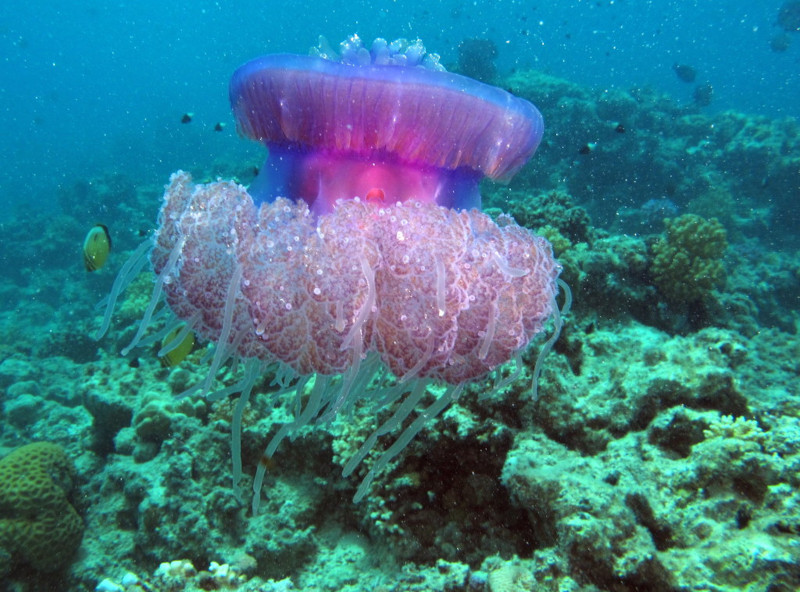
Cauliflower Jellyfish Facts
- This mesmerizing creation of Nature and evolution most frequently goes by the distinctive common name of the Cauliflower Jellyfish. The Cnidarian does have at least one other general title, though. That’s the very similar moniker of crown jellyfish.
- Inside of scientific circles, however, the animal’s perhaps better known by its technical designation. Thankfully, that’s a relatively simple term for the layperson to pronounce. That’s because the species holds the formal epithet of the Cephea cephea.
- It received that short official honorific due to the efforts of Peter Forsskål. The respected Finnish naturalist accomplished the first recognition of it as a separate and distinct species, in 1775. At that time, though, he attributed a different designation to it.
- Pleasantly, the amazing Cauliflower Jellyfish appears to be maintaining a population base that’s both stable and sufficient. That fortunate situation also seems to hold true throughout the entirety of its ragne. The IUCN therefore has no listing for the creature.
- Nonetheless, it must be considered to be currently facing the same threats to its continued existence as all species on earth. Most of these stem from the actions of mankind. These include the often-related perils of habitat loss and climate change.
Related Articles
Cauliflower Jellyfish Physical Description
The fabulous Cauliflower Jellyfish immediately captures the attention and appreciation of those lucky enough to view it. Yet, it does so for more than one reason. That’s true due to the fact that this marvel of Nature possesses qualities of both beauty and size.
Following the pattern common to members of its Phylum, this amazing animal displays no noticeable degree of the physiological characteristic of sexual dimorphism. Visually distinguishing the genders is therefore nearly impossible for the untrained observer.
In terms of dimensions, it represents an approximately medium-sized Cnidaria. Mature adults attain a maximum known diameter of their bell or roughly 23.6 in (60 cm). These, however, represent exceptional specimens. The majority of individuals never approach this.
It does stand out physically from many of its relatives in one manner relating to its appearance, though. That concerns the shape of its bell. That’s due to the presence of a deep groove extending around the bottom of the umbrella. This creates a cauliflower shape.
In terms of coloring, both genders of the Cauliflower Jellyfish also present the same basic patterns. This consists of the upper portion of the body displaying a predominantly purplish-blue shade. Meanwhile, the lower part most typically shows an off-white hue.
This shading extends to the multiple tentacles dangling from the underside of the incredible animal. These appendages vary in length, but generally grow comparatively short compared to other jellyfish. Each, however, contains cells holding a highly potent toxin.
- Kingdom: Animalia
- Phylum: Cnidaria
- Class: Scyphozoa
- Order: Rhizostomeae
- Family: Cepheidae
- Genus: Cephea
- Species: C. cephea
Cauliflower Jellyfish Distribution, Habitat, and Ecology
The intriguing Cauliflower Jellyfish evolved as endemic to a comparatively broad expanse of the marine regions of the globe. The full extent of the zone of habitation might surprise many people, though. It’s unknown, however, if it ever appeared beyond this range.
Presently, this marvel of evolution inhabits an area that includes portions of several Oceans. These regions consist of the eastern Atlantic and Indo-West Pacific Oceans. Yet its territory doesn’t end there. That’s true since it also appears in sections of the Red Sea.
Nature also provided this species with a moderately impressive flexibility in its choice of habitat. In some ways this remains quite specific. Yet, in other respects, it’s evolved an intriguing adaptability. This serves to provide the creature with an evolutionary advantage.
It only appears in either tropical or sub-tropical areas within its greater overall range. Inside of those areas, though, it’s found at different depths. During the day, it dives to known depths of as much as 3,000 ft (914 m). At night, however, it rises to the surface itself.
Like all its kind, the Cauliflower Jellyfish developed as omnivorous in nature. It actively hunts its various prey, rather than act as an ambush predator. Though it feeds opportunistically, its main food source consists of shrimp, algae, plankton, and larvae.
In turn, its own primary predators include sea turtles. It utilizes its venom within its tentacles in defense. Though among the most toxic of its kind, its venom rarely poses a threat to humans. In the wild, this species typically has a lifespan of around 6 months.
Species Sharing Its Range
Check out our other articles on 5 Terrific United States Trees, Marbled Polecat, Great Barrier Reef, Agile Ground Mantis, Santa Rosa Island Manzanita, Wolf Eel, Alligator Snapping Turtle
